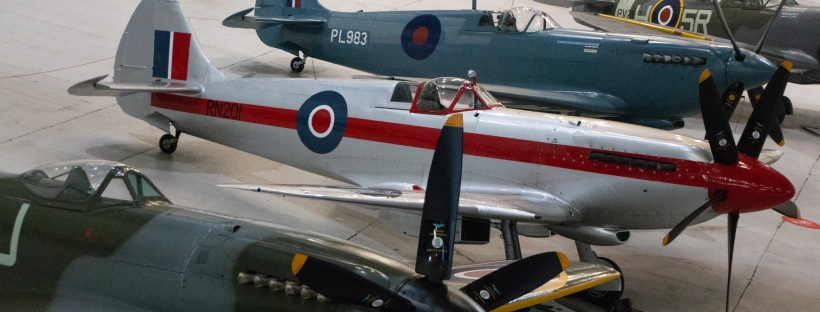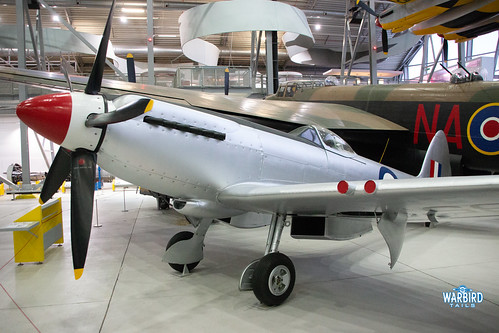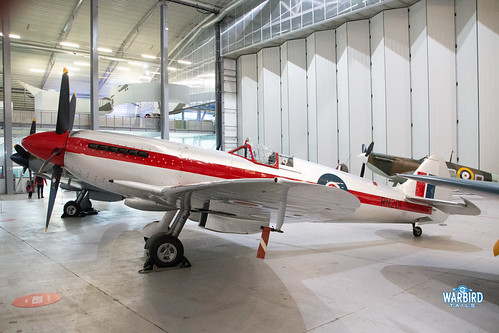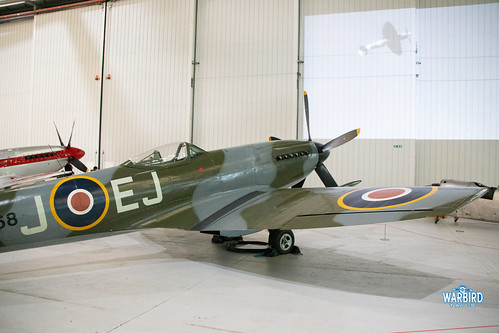Duxford and the Supermarine Spitfire go hand in hand and have been a key part of a joint story for over 80 years now. With Duxford having been home to a huge number of static and airworthy examples of the type from the Mk I to Mk 24, it would be quite the challenge to come up with a fresh way of presenting this iconic design.
However, Duxford managed just that with the new Evolution of an Icon exhibition in Airspace. It’s always good to see the conservation hall of airspace being used for aircraft displays, rather than the corporate events it often hosts. The idea of this exhibition is quite simple, it is designed to show the progression of the Spitfire design through airworthy examples (or restoration projects) based at Duxford.
The overall collection of Spitfires assembled is very impressive in itself, with the development of the fighter bookended by Imperial War Museum’s own Spitfire I N3200 and the Fighter Collection’s Spitfire XXII. The latter has been in storage at Duxford for many years, pending an eventual restoration. On show in it’s core component parts (wings, tail, fuselage and engine) this offered a chance to not only see how far the Spitfire design was taken, but also how the internal construction looked. For visitors looking for a more complete image of the ultimate Spitfire design, it was only a short walk to the back of the main airspace hangar and the Imperial War Museum Spitfire F.24.
The intervening years of Spitfire development were wonderfully illustrated, with some rare examples on show. The second Mk I on display was Comanche Fighters AR213. This illustrates the later Mk I development and also is an iconic airframe for UK enthusiasts having spent many years being one of the only civilian operated Spitfires.
The next significant step for the Spitfire came with the V. The exhibition featured three examples of the variant (a rare feat in itself) showcasing the different wing configurations used on the type. The Historic Aircraft Collection Vb BM597, in it’s new Polish Heritage Flight scheme represented the “B” wing, featuring a cannon on each wing. Another long time Duxford resident was next in the form of The Fighter Collection’s EP120. This airframe was one of two on display showing off clipped wings, a modification made to improve low level manoeuvring. The final Mk V was the second Comanche Fighter’s Spitfire, JG981. This example is a MkVc with a distinctive “C” wing featuring two cannons on each wing. There are not many airworthy Spitfires with this configuration and combined with the desert paint-scheme makes for a unique machine.
Another icon followed, with Spitfire IX MH434. For many this aircraft is the ultimate Spitfire having been a part of the UK airshow season for decades now and become legend in the hands of Neil Williams, Mark Hanna and of course, Ray Hanna. Since Ray’s death the Old Flying Machine Company have continued to operate the aircraft and it can regularly be seen performing in typically fine style at airshows around the country.
Though out of numerical order, Spitfire VIII MT928 represents a further development of the Mk IX airframe. The VIII is a rare machine in terms of airworthy Spitfires, with ‘928 being the only single seat example outside of Australia. The main feature of the VIII is a retractable tailwheel, a feature not present on the Mk IXs.
If there is one variant of the Spitfire that has taken on a story of it’s own in the last few years or so, it has to be the two-seat IX. It is fitting that the Aerial Collective Spitfire PV202 was included in the display, illustrating another important part of the story. Spitfire XI PL983 was already a significant enough Spitfire before the pandemic hit, being one of only two airworthy XIs in the world. In 2020 another chapter of this airframe’s story was written as it became known as the NHS Spitfire. The aircraft still wears the “THANK U NHS” message underneath and the handwritten names of those who have donated to the NHS Spitfire campaign.
Closing the circle was the rare chance to enjoy two Spitfire XIVs next to each other. Both airframes have long histories with Duxford, though both are under new ownership. The XIV had a number of different variants, most notably high and low back. The exhibition had examples of each. MV293 is a low back variant, with a bubble canopy for increased visibility alongside clipped wings. This airframe was a long-term part of the Fighter Collection before moving on to Anglia Aircraft Restorations in 2016. Now being operated by Ultimate Warbird Flights ‘293 continues to show off the impressive power of these later Spitfires at Duxford and around the UK and Europe. The other XIV on display has made a recent return to these shores. RN201 wears the distinctive racing scheme originally worn by a Spitfire XXI, making it one of the most striking examples of the Spitfire flying today. After making a great pairing alongside Spitfire XVI TD348 the wore the same scheme, ‘201 departed for the states in 2006. Late 2019 initially saw the airframe return to the UK through Sywell, before returning to the skies in 2020. In 2021 the Spitfire relocated to Duxford and is now under the care of the aircraft restoration company. This exhibition was the first real chance to get up close to this much loved example of the Spitfire.
The Imperial War Museum have put together something very impressive here with this exhibition. I look forward to seeing what next winter may bring. With many other famous collections and types on site, there are many themes that could benefit from a similar treatment and would help freshen up the often static airspace exhibition. It also gives a chance for some Duxford regulars normally buried in amongst other aircraft a chance to stand out, not to mention great viewing opportunities from the balcony.










Another interesting post! I visited the exhibition myself last week and even sat in N3200.
LikeLike